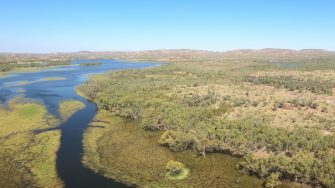
Date: Thursday 5th October 2023
Project: Eastern Australian Waterbird Survey
Observers: John Porter (NSW DPE), Shannon Dundas (NSW DPI)
Trainee: Chris Sanderson (Qld DES)
Pilot: Thomas Clark
After departing Airlie Beach we head west across the floodplain of the Proserpine River, counting on several small dams and impoundments before reaching Proserpine Dam. This large water reservoir (4,350 ha) was built in 1990 to provide water supply and flood mitigation for the region, however it has also changed the natural flow patterns of the river, affecting the timing, frequency, duration and magnitude of floods and drought which can impact the reproduction and life cycle of dependant aquatic plants, fish, frogs, invertebrates and waterbirds. The dam had thousands of Eurasian Coot, Black Swan and Hardhead while cormorants, Grey Teal, Wood Duck, Green Pygmy Geese and Black Duck were also abundant.
Further we west we start counting along the Bowen River where we encounter several small parties of majestic Black Necked Stork as well as egrets, herons and cormorants. The water in several of the deeper pools had cleared allowing extensive beds of aquatic plants to grow.
Following this we travlled to our next survey section which includes the Burdekin River with its spectacular stoney canyons and rapids.
Burdekin River
The Burdekin River is one of the largest rivers in Australia by discharge volume and flows into the Coral Sea at Upstart Bay. It has a catchment area of about 130,000 square kilometres and is fed by several tributaries, including the Suttor, Star, Bowen, and Cape rivers.
Today the river is flowing strongly and the water levels are relatively high. We spot low numbers of waterbirds (but we do see several crocodiles) until we reach the Burdekin Falls Dam and the massive impoundment of Lake Dalrymple (22,400 ha).
Burdekin Falls Dam
Surveying Burdekin Falls Dam
Lake Dalrymple
Surveying Lake Dalrymple
We counted moderate numbers of waterbirds on the main area of Lake Dalrymple and found the largest numbers congregated in the shallow waters around the edge of the water, seeing mainly Wood Duck, cormorants and egrets. As we head further west we cross the rocky tablelands of the White Mountains with waterbodies becoming much less frequent until we near Mt Isa.
Lake Moondarra is a large dam on the Leichhardt River that provides water to the town of Mt Isa and the adjacent mining operations, it is usually a magnet for waterbirds so we were looking forward to counting it. We were not diappointed as we found large numbers of waterbirds, mainly Grey Teal, cormorants, egrets, ibis, herons, Pygmy Geese and grebes.
Surveying Lake Moondarra part 1
Surveying Lake Moondarra part 2
Lake Moondarra

